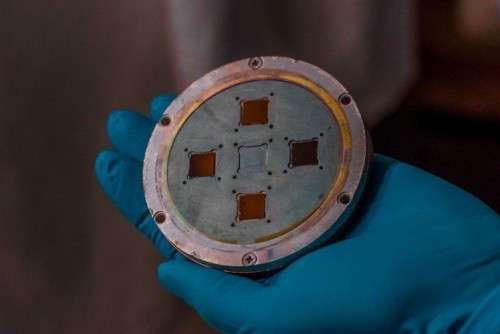A New Spin On Computer Technology From Physicists
From a team of DU physicists, new research has the potential to serve as the foundation for next-gen computer technology.
In the quest to make computers faster and more efficient, researchers have been exploring the field of spintronics—shorthand for spin electronics—in hopes of controlling the natural spin of the electron to the benefit of electronic devices. The discovery, made by Professor Barry Zink and his colleagues, opens a new era for experimental and theoretical studies of spin transport, a method of harnessing that natural magnetization, or spin, of electrons.
“Our approach requires a fundamentally different way of thinking about the nature of how spin moves through a material,” Zink said.
Computers currently rely on electrons to process information, moving data through tiny, nano-sized wires. These electrons generate heat, however, as they travel through the wires. This heat, along with other factors, limits computer speed.
Past research has successfully demonstrated spin transport using crystalline, or ordered, materials as magnetic insulators. In Zink’s new study, recently published in Nature Physics, the team was able to demonstrate spin transport through a synthetic material that is notably amorphous, or non-ordered, both magnetically and structurally.
The discovery is significant because manufacturing this amorphous synthetic material, known as yttrium iron garnet, is easier than growing the silicon crystals currently used in computer processors.
“The existing materials known to have this type of spin transport are difficult to produce,” Zink said. “Our material is very easy to produce, simple to work with and potentially more cost-effective.”
Dean Andrei Kutateladze of the Division of Natural Sciences and Mathematics emphasizes the significance of the team’s findings.
“This spectacular result from the Zink research group amply illustrates the vibrant research environment in the division, where teacher-scholars create new knowledge working hand-in-hand with students,” he said. “It also underscores the critical importance of support for fundamental research. Just as basic research in Bell Labs in the ’50s and ’60s paved the way for smartphones and other wonders of the current technological revolution, physicists such as Dr. Zink are building platforms for the next great technological leap.”
The research team includes Davor Balzar, chair of DU’s Department of Physics and Astronomy, graduate students Devin Wesenberg and Rachel Bennett, newly minted doctorate holder Alex Hojem and colleagues at Colorado State University. The scientists carried out their research using custom-designed micromachined thermal isolation platforms in DU’s physics laboratories. The team’s next step is to undertake more testing and verification.
“We’re looking to see if we can reproduce this in different types of amorphous materials, as not a lot is known about such materials,” Zink said. “Twenty years from now, they could be an important part of how computers work.”
A core mission of DU’s Division of Natural Sciences and Mathematics is to offer students unprecedented access to research opportunities. By working alongside distinguished faculty mentors in state-of-the-art facilities, undergraduates and graduates are able to apply their newfound knowledge to research that changes lives and challenges ideas.



Comments are closed, but trackbacks and pingbacks are open.